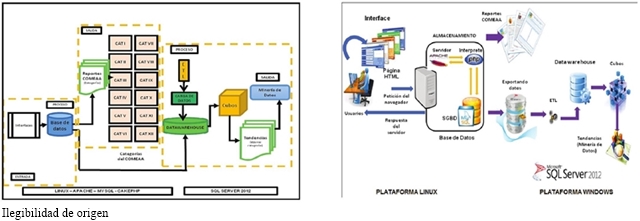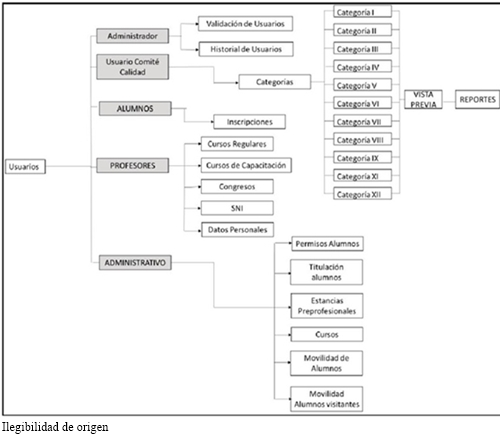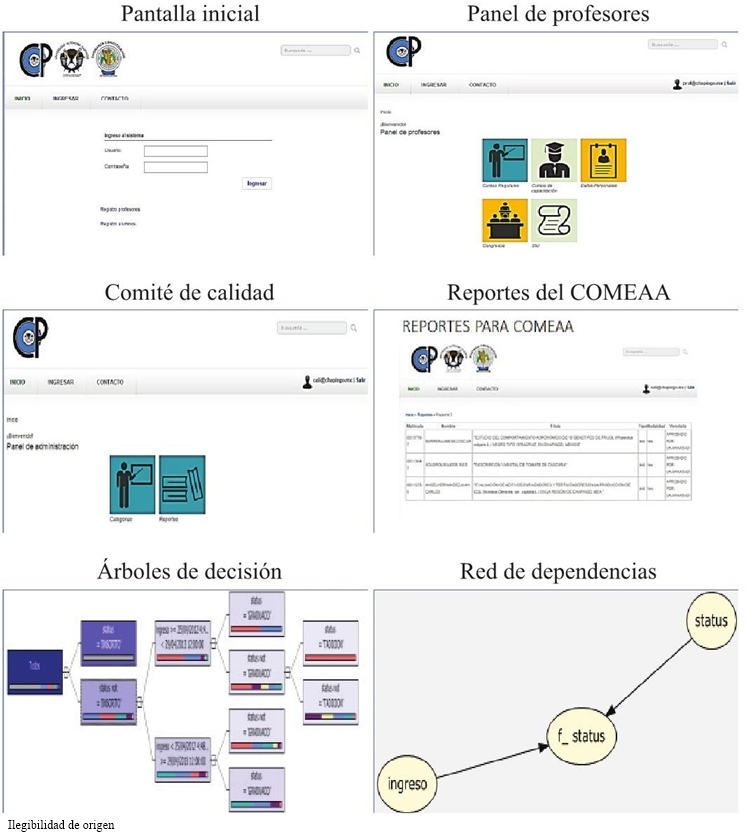Serviços Personalizados
Journal
Artigo
Indicadores
-
 Citado por SciELO
Citado por SciELO -
 Acessos
Acessos
Links relacionados
-
 Similares em
SciELO
Similares em
SciELO
Compartilhar
Revista mexicana de ciencias agrícolas
versão impressa ISSN 2007-0934
Rev. Mex. Cienc. Agríc vol.8 no.2 Texcoco Fev./Mar. 2017
https://doi.org/10.29312/remexca.v8i2.64
Investigation Note
Proposal of a computer system for the management of agricultural educational quality (SIGCEA)
1Colegio de Postgraduados-Campus Montecillo. Carretera México-Texcoco, km 36.5. Montecillo, Texcoco, Estado de México. CP. 56230. Tel. (01) 5558045900, ext. 1414. (diana.barrera@colpos.mx; jlgcue@colpos.mx; escobar@colpos.mx).
2Edificio Carlos Graef T-163. Av. San Rafael Atlixco No. 186. Colonia Vicentina Iztapalapa, Ciudad de México. CP. 09340. (cmed@xanum.uam.mx).
3Carretera México-Texcoco, km 38.5. Chapingo, Estado de México. CP. 56230. Tel. (01) 595 9521500, ext. 1782. (eesantacruz@gmail.com).
The objective of the present work was to propose a computer system for agricultural quality management (SIGCEA) to support the process of accreditation to COMEAA of the academic unit of phytotechnology (UAF) of the Autonomous University Chapingo (UACH) and also allows identifying some trends that contribute to plans for continuous improvement. We began by analyzing the Mexican organizers who are in charge of educational quality. Afterwards, the methodology used for the development of SIGCEA was described. Finally, the results of a part of the SIGCEA, in particular the section V students of the COMEAA instrument that includes the database, navigation map, some interfaces, reports and tendencies through data warehouse and data mining are shown. The web system Proposed is scalable and portable considering the short-term needs of the UAF, as well as some changes that may be proposed in COMEAA.
Keywords: database; educational quality; data warehouse; SIGCEA
El presente trabajo tuvo por objetivo proponer un sistema informático de gestión de calidad educativa agrícola (SIGCEA), que apoye el proceso de acreditación ante el COMEAA de la unidad académica de fitotecnia (UAF) de la Universidad Autónoma Chapingo (UACH) y además permita identificar algunas tendencias que coadyuven en planes de mejora continua. Se comenzó analizando los organizamos mexicanos que están encargados de la calidad educativa. Después, se describió la metodología empleada para el desarrollo del SIGCEA. Al final se muestran los resultados de una parte del SIGCEA, en particular la sección V alumnos del instrumento COMEAA que incluye la base de datos, mapa de navegación, algunas interfaces, reportes y tendencias a través de data warehouse y minería de datos El sistema web propuesto es escalable y portable considerando las necesidades a corto plazo de la UAF, así como algunos cambios que pueden proponerse en el COMEAA.
Palabras clave: base de datos; calidad educativa; data warehouse; SIGCEA
Since 1921, the Mexican Ministry of Public Education (SEP) has been responsible for administering the different levels of education, with the essential purpose of creating conditions that ensure the access of all mexicans to quality education at the level and modality that requires it (SEP, 2011). In the upper level, the Mexican Federal Government has implemented various strategies, in 1978 appeared the Law for the Coordination of Higher Education, published in the Official Gazette of the Federation (LCES, 1978).
In 1987 the International Organization for Standardization (ISO) was established, with a series of rules concerning the quality of products and named ISO 9000 (García-Cue et al., 2015), in 2001 the council ISO established a workshop entitled “International Workshop Agreement (IWA)” for the application of ISO 9001: 2000 in education with a focus on Mexico (Sánchez-Rodríguez, 2011). In 1991, the interinstitutional committees for the evaluation of higher education (CIEES) were established for the Assurance of the quality of mexican higher education (CIEES, 2014).
The highest authority at present of the CIEES is its assembly constituted by the Undersecretariat of Higher Education of the SEP, the National Association of Universities and Institutions of Higher Education of the Mexican Republic, AC (ANUIES), the Federation of Mexican Institutions Particular de Higher Education, AC (FIMPES), among others. The CIEES offers specialized services in standardization, testing, evaluation and certification based on the parameters set by the ISO and proper for Mexico (IMNC, 2013).
In 2000, the Council for the Accreditation of Higher Education (COPAES) was established, which is the only body endorsed by the SEP, to grant accreditation for academic programs of higher education, or, to put it somehow, it functions as the “accrediting the accreditors” (COPAES, 2014). The SEP, through national coordination for higher education planning, supported by CONAEVA and ANUIES, established that the promotion and evaluation of the quality of higher education academic programs should be done through specialized agencies, which made it necessary to establish bodies for each professional branch that meet the social demands and educational policies established by the SEP (COMEAA, 2013).
An example of these organisms was the Mexican Association of Higher Agricultural Education AC (AMEAS), which, in agreement with the CIEES agricultural science committee, promoted the mexican committee for the accreditation of agronomic education, AC (COMEAA). A non-governmental accrediting organization recognized by COPAES in 2002, with the objective of accrediting higher education academic programs in the areas of agronomy, forestry, zootechnics and agro-industries (CIEES, 2014).
A particular case of the institutions that make use of various accreditations of their academic programs is that of the Autonomous University Chapingo (UACH) of Mexico -an institution focused on the agricultural sciences- that uses different instruments to evaluate the quality of its 22 academic units through five accrediting agencies and in their postgraduate studies through the National Quality Graduate Program (PNPC) of the National Council of Science and Technology -CONACYT (Rueda and Victorino, 2009). The academic unit of phytotechnology (UAF), one of the 22 academic units of the UACH, obtained accreditation of its academic program of Agricultural Engineering Phytotechnology (IAEF) through COMEAA in May 2005, with a validity of 5 years, through a process of self-evaluation, so in May 2011 was requested to develop the re-accreditation process and in October 2011 was endorsed until October 16, 2016 (Fitotecnia, 2014).
The COMEAA instrument that uses the UAF consists of 12 sections: i) normativity and general policies; ii) academic-administrative management of the program; iii) planning-evaluation; iv) educational model and curriculum; v) students; vi) academic staff; vii) student support services; viii) facilities, equipment and services; ix) importance of the program; x) academic productivity in teaching; xi) academic productivity in research; and xii) linkage with the sectors of society (Rueda and Victorino, 2009). The process of filling the sections is done in a craft way and is produced by responsible managers, teachers and administrators; it is integrated and validated by a quality assurance committee of the UAF.
The information is made by hand and different supporting documents are added in different formats (doc, pdf, jpg, etc) as well as diverse information coming from different institutional databases that are only delivered to the UAF in the form of reports. A computer system is proposed to support the automation of the COMEAA self-evaluation process, which is scheduled for 2016. To begin, a next step was the analysis of needs, through the opinions of managers, teachers, students and administrative workers of the UAF on the procedure for the quality of their academic unit through the implementation of COMEAA, meeting them in a group in November 2014.
The results of this meeting highlights the non-existence of the automated procedure with web access, through a computer and the need to do so. The following research question: What characteristics should a computer system that serves as a tool to integrate the information requested by COMEAA for the Academic Unit of Phytotechnology (UAF) of the Autonomous University Chapingo (UACH)?, In order to answer the question a research was proposed that had as objective to propose an Agricultural Educational Quality Management System (SIGCEA) to serve as a support in the process of accreditation to the COMEAA of the Academic Program Agricultural Engineer, Specialist in Phytotechnology of the UAF and of UACH and also to identify some tendencies that contribute in plans of continuous improvement.
In order to comply with this, a computer system was proposed through an interface that manages different relational databases, with Data Warehouse applications that help to speed up the compilation, systematization and analysis of information required by COMEAA in its terms of reference and allows you to see the trends that the UAF has through reports or data mining processes.
Metodología
The system design was based on different models used to build applied to education and software based on concepts and best practices of software engineering such -as the Lawrence-Pfleenger and Atlee (2010), Peña-Ayala (2006), Alonso et al. (2005)- the different phases for the development of SIGCEA are:
Phase 1. Definition of the problem: an analysis of the COMEAA instrument and of each one of its categories that included all the information quantitative as well as qualitative. Afterwards, we were carried out the information and accreditation process that followed the academic unit of phytotechnology (UAF) for COMEAA. Later, the most recent self-assessment report was verified through the Quality Assurance Committee (CAC) of the UAF. The information obtained by the Autonomous University Chapingo (UACH) was then obtained to comply with the COMEAA and the opinions of managers, teachers, students and administrators were taken into account.
Phase 2. Analysis of the system and its requirements: It was detected that the academic unit of phytotechnology (UAF) has the need to have a web-based computer system to obtain, process and deliver reliable information that contributes to the accreditation processes required by COMEAA, in addition, through its reports, identify trends that serve the plans for continuous improvement that help maintain the quality of the educational program of Agricultural Engineering Specialist in Phytotechnology (IAEF) of the UAF.
Phase 3. Design: We proposed a general diagram and the architecture that will have the computer system (Figure 1). Of the architecture stands out:
Users. Teachers, students, secretaries and administrative staff of the academic unit of phytotechnology that can access the system and that can also make, drop, change, delete and consult information from the database for COMEAA.
Interfaces. Computer programs by which the user communicates with SIGCEA via the web.
Database. Based on Camps-Pare (2002) and has the information to prepare COMEAA reports. We considered the relational model and the use of open source software for its elaboration and LINUX platform.
Data warehouse. Based on Kimbal and Ross (2002); Charte (2012). It was proposed to work under MS SQL Server 2012 on Windows exporting the data from MySQL. We took advantage of the nature of the data warehouse to handle more accurate information for the creation of reports for COMEAA. Also, the data mining capabilities of MS SQL Server 2012 were used to identify trends in the data.
Phase 4. Construction. The general structure of the system was considered according to the one proposed in Figure 1. Afterwards, software was installed to work under LINUX and Windows which consisted of an Apache Server, MySQL and MS SQL Server 2012, among other tools. Later on, the databases and the relationships between the tables were elaborated. Next, the interfaces were programmed to access the databases, that is, to be able to perform: upload, download, change and delete data with HTML, CSS, JavaScript, JQuery and JQueryU and CakePHP Framework. Later, the reports of the databases were generated according to the COMEAA with CakePHP Framework, after the export of the data of Linux platform to the Platform Windows and of MySQL to SQL Server was made to elaborate the Data warehouse from the data source of the original DB in MySQL with information requested by COMEAA.
Afterwards, the data were transformed (cleaning, combining, homogenizing units of measurement, code equivalences, among other things). The Data Warehouse was then “targeted” or detailed with the information required by COMEAA. Later, cubes composed of a single DB, by multiple (data mart) or by both were elaborated. Subsequently, tests were carried out to construct the information requested by COMEAA (reports, graphs, dynamic Excel tables, among others). Data mining algorithms, especially decision trees and trends network, were tested later in MS SQL Server 2012 tools to identify trends in COMEAA data.
Phase 5. Implementation. In this phase the results of the implementation of one of the parts of the SIGCEA, that is, of the category V and students of the COMEAA are shown. To begin, a database was created consisting of 38 main tables in a relational schema, 1 diagram, 1 schema, 45 indices and 37 main keys. Next, the navigation map of the SIGCEA interface was proposed (Figure 2). In the map you can distinguish the different options that can be accessed by different users of the system: administrator, quality committee, students, teachers and administrative staff.SIGCEA clearly defines the actions that users can take, ie, highs, lows, changes to the database and in some cases the reports of each of the categories of COMEAA.
In the Figure 3 shows some windows of the programmed interfaces. It also shows the reports that are carried out through the database and the data warehouse, as well as the trends through decision tree and dependency network.
Conclusions
The proposal of a system supported both in software for education, and in concepts and good practice of software engineering.
The system described is a prototype that implements the first sections requested by the COMEAA, it is considered to finish the other blocks given the viability of the adopted approach. It is considered to be evaluated in August 2016 when the following evaluation of the COMEAA in the academic unit of phytotechnology is made. The UAF database was proposed on MySQL under Linux on APACHE server, the interface with HTML, CSS, JavaScript, JQuery and JQueryU CakePHP Framework was programmed for the whole system and it was tested for category V of COMEAA students.
The proposed web system considers evolution, scalability and portability according to the needs of the UAF and changes that may be proposed in COMEAA. In the future it is considered to propose strategies that allow to evaluate the operation of the system adhering to attributes of software quality.
Literatura citada
Alonso, F.; Martínez, N. F. y Segovia, J. 2005. Introducción a la ingeniería de software. Modelo de desarrollo de programas. Madrid: Delta publicaciones universitarias. 436 p. [ Links ]
Camps, P. R. 2002. Bases de datos. UOC. (La Universidad Virtual). Barcelona, España. UOC. 73 p. [ Links ]
Charte, F. 2012. SQL Server 2012. Manual imprescindible. Madrid., España. Anaya. 59 p. [ Links ]
Comités Interinstitucionales para la Evaluación (CIEES). 2014. http://www.ciees.edu.mx/ [ Links ]
COMEAA (comité mexicano para la acreditación de la educación agronómica, AC). 2013. COMEAA obtiene por segunda ocasión el refrendo de su reconocimiento por parte de la SEP- COPAES. http://www.comeaa.org. [ Links ]
Consejo para la Acreditación de la Educación Superior A. C. (COPAES). 2014. http://www.copaes.org/. [ Links ]
Fitotecnia 2014. El departamento de fitotecnia de la UACH. http://www.chapingo.mx/fitotecnia/index.html. [ Links ]
García, C. J. L.; Antonio, P. y Gutiérrez, T. M. 2015. Estilos de aprendizaje y su relación con el instrumento EGEL de CENEVAL. Journal of Learning Styles 16(8):211-250. http://learningstyles.uvu.edu/index.php/jls. [ Links ]
Gento, P. S. 1998. Implantación de la calidad en instituciones educativas. Madrid, España. Graba. 621 p. [ Links ]
Instituto Mexicano de Normalización y Certificación AC. (IMNC). 2013. http://www.imnc.org.mx/. [ Links ]
Kimball, R. and Ross, M. 2002. The data warehouse toolkits: the complete guide to dimensional Modeling. New York: Wiley & Sons. 290 p. [ Links ]
Lawrence, P. S. and Atlee, J. M. 2010. Software engineering: theory and practice. New York: Prentice Hall. 91 p. [ Links ]
LCES. 1978. Ley para la Coordinación de la Educación Superior. http://www.diputados.gob.mx/LeyesBiblio/pdf/182.pdf. [ Links ]
Peña, A. A. 2006. Ingeniería del software: una guía para crear sistemas de información. Instituto Politécnico Nacional. México. 64 p. [ Links ]
Rueda, H. y Victorino, L. 2009. Análisis de los procesos de acreditación de los programas académicos de licenciatura de la Universidad Autónoma Chapingo. In: Memorias del X Congreso Nacional de Investigación Educativa- Área 13: política y gestión. http://www.comie.org.mx/congreso/memoriaelectronica/v10/index.htm. [ Links ]
Sánchez, R. J. 2011. ISO 9001: 2008 como estrategia para el cambio organizacional. Tesis de Maestría. Instituto Politécnico Nacional (IPN)- Unidad Profesional Interdisciplinaria de Ingeniería y Ciencias Sociales y Administrativas. http://www.repositoriodigital.ipn.mx/bitstream/handle/123456789/15885/tesis%20listo.pdf?sequence=1. [ Links ]
Secretaría de Educación Pública (SEP). 2011. http://www.sep.gob.mx/es/sep1/educacion-por-niveles. [ Links ]
Received: January 2017; Accepted: February 2017











 texto em
texto em 





